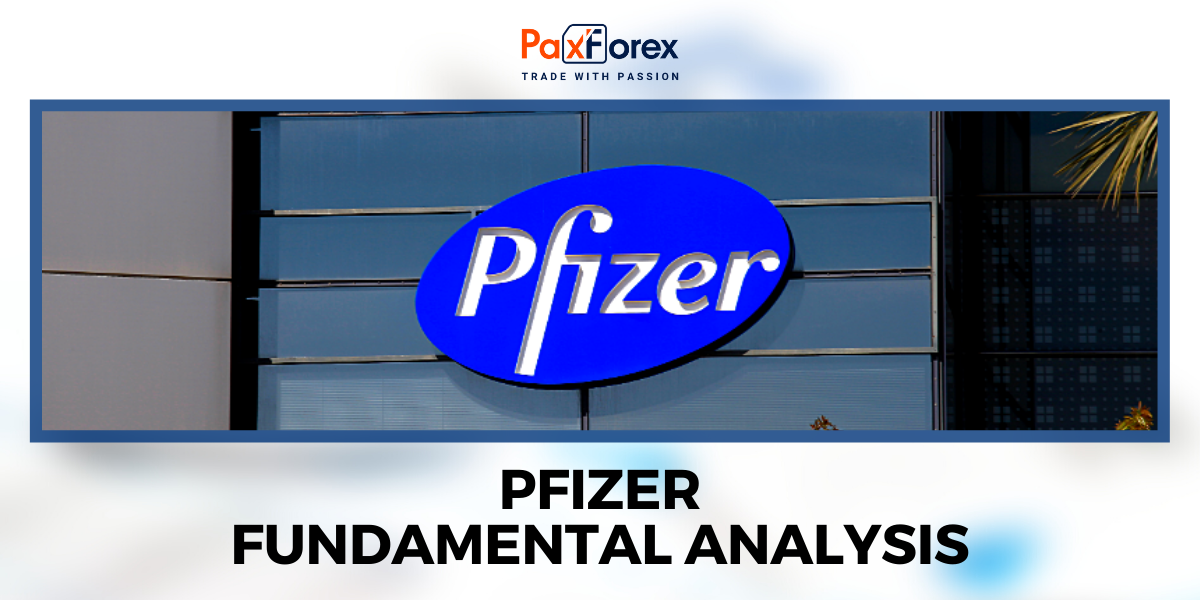
Source: PaxForex Premium Analytics Portal, Fundamental Insight
At first glance, it might seem that market would be thrilled about a company that just posted revenues of $22.6 billion and profits of nearly $10.2 billion in its most recent quarter. But it's exactly the opposite.
Last week, Pfizer announced its Q3 results. Although shares rose slightly after the release of the impressive numbers, the pharmaceutical company's stock is still down nearly 20% YoY.
CEO Albert Bourla understands why investors aren't thrilled. He said there are questions about Pfizer's long-term growth prospects, particularly between 2025 and 2030. Bourla acknowledged that Pfizer is projecting a revenue impact of about -$17 billion due to the loss of exclusivity for several top-selling drugs in that period.
We understand why many are wary of the company's opportunities in the second half of this decade. But is Pfizer stock really worth buying, even with an impending $17 billion drop in revenue?
There is one crucial thing to know about Pfizer's impending loss of exclusivity (LOE): The company believes it will more than offset the impact on earnings. Definitely, management is sure it will be able to do so from the additional sales that will come from products launched so far this year and over the next 18 months. The drug maker estimates that these new products will add about $20 billion in revenue by 2030.
In the Q3 earnings call, Bourla said Pfizer will bring as many as 19 new products or indications to market over the next 18 months. He noted that more than two-thirds of them have the potential to generate at least $1 billion in annual sales.
Such products include Pfizer's respiratory syncytial virus (RSV) vaccine. The company recently reported the positive results of using this experimental vaccine in maternal immunizations to protect infants against RSV.
Pfizer expects even more positive effects from its business development deals. The company predicts at least $25 billion in additional risk-adjusted revenue from acquisitions and other business development deals by 2030.
Bourla said Pfizer's acquisitions of Arena, Biohaven, Global Blood Therapeutics, and ReViral could provide more than a third of that revenue. With strong cash flow and a huge cash reserve of more than $33 billion as of June 30, the company should have no problem continuing to wheel and deal.
Pfizer also has a few trump cards. Chief among them is the company's coronavirus treatment and vaccine products. No one expects sales of the Comirnati vaccine and the antiviral drug Paxloid to remain at current levels. The question, however, is how much sales will drop in the future.
Pfizer believes that its COVID-19 products will continue to generate billions of dollars in annual revenue for years to come. Asked by an analyst whether the drugs could still generate $15 billion in total revenue in 2030, Bourla said it was "not unreasonable" to expect that level of sales.
Another important factor for Pfizer is the rest of its program, beyond the expected launches over the next 18 months. These programs include gene therapy candidates for hemophilia and Duchenne muscular dystrophy, a promising candidate for diabetes and obesity, and the combination flu vaccine COVID. Pfizer has not publicly disclosed its earnings expectations for these candidates.
Back to our original question: is Pfizer stock worth buying given the looming impact of LOEs on -$17 billion in revenue? There are two answers to that question.
For income-oriented investors, Pfizer remains a great buy. The dividend yield is over 3.4%. Pfizer will almost certainly continue to prioritize its dividend program. Investors can expect solid dividend income over the long term.
If you are not income-oriented, the answer to our key question is "maybe." It's important to understand Pfizer's risks. The company's LOE performance is not questionable; expected product launches and business development deals are. Pfizer may not deliver the projected growth. On the other hand, a major drug maker may exceed expectations.
Pfizer will probably more than makeup for the impact on earnings from the upcoming LOEs. If the company lives up to its projections, the stock should deliver an attractive total return - perhaps even enough to spark investor interest again.
As long as the price is above 46.00, follow the recommendations below:
- Time frame: D1
- Recommendation: long position
- Entry point: 47.30
- Take Profit 1: 49.00
- Take Profit 2: 51.00
Alternative scenario:
If the level of 46.00 is broken-down, follow the recommendations below:
- Time frame: D1
- Recommendation: short position
- Entry point: 46.00
- Take Profit 1: 45.00
- Take Profit 2: 43.00













